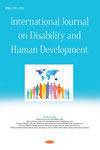Game technology to increase range of motion for adolescents with cerebral palsy: a feasibility study
International Journal on Disability and Human Development
Pub Date : 2017-01-28
DOI:10.1515/ijdhd-2016-0026
引用次数: 7
Abstract
Abstract Background: People with cerebral palsy (CP) experience limitations in motor control, strength, and range of motion (ROM). Abnormal movements caused by motor impairments commonly occur in people with CP. Activities of daily living (ADLs) can be seriously affected by insufficient ROM among others. To increase ROM, this study assessed the possibility of training three adolescents with CP using a Kinect-based system in a public school setting. Methods: We gamified the movement training by leveraging the Scratch language and the Kinect2Scratch tool that allowed the therapists to perform individual customization with less technical support. This experiment was carried out according to an ABAB reversal replication design in which A represented the baseline and B represented the intervention phases. Three adolescents in a public special-education school participated in the experiment. Results: Data showed that the three participants significantly increased their shoulder ROM and motivation of engaging in rehabilitation as well, thus improving exercise performance during the intervention phases. Conclusion: Despite that, the game is a promising and highly accepted training tool for school use, currently, it is still error-prone, and the requested support exceeds the support that can be provided by clinical therapists. A technically more robust system, combined with additional attractive games, likely results in higher patient motivation and better compliance. This would reduce the need for parents to motivate their children extrinsically and allow for clinical trials to investigate the effectiveness of the system.游戏技术增加青少年脑瘫患者活动范围的可行性研究
摘要背景:脑瘫患者在运动控制、力量和运动范围方面存在局限性。运动障碍引起的异常运动通常发生在CP患者身上。ROM不足等因素会严重影响日常生活活动。为了提高ROM,本研究评估了在公立学校环境中使用基于Kinect的系统训练三名CP青少年的可能性。方法:我们利用Scratch语言和Kinect2Scratch工具将动作训练游戏化,使治疗师能够在较少的技术支持下进行个性化定制。该实验根据ABAB反向复制设计进行,其中A表示基线,B表示干预阶段。一所公立特殊教育学校的三名青少年参加了实验。结果:数据显示,三名参与者显著提高了他们的肩部ROM和参与康复的动机,从而提高了干预阶段的运动表现。结论:尽管如此,该游戏是一种很有前途且被广泛接受的学校使用的培训工具,但目前它仍然容易出错,所要求的支持超过了临床治疗师所能提供的支持。一个技术上更强大的系统,再加上其他有吸引力的游戏,可能会带来更高的患者动机和更好的依从性。这将减少父母从外部激励孩子的需要,并允许进行临床试验来调查该系统的有效性。
本文章由计算机程序翻译,如有差异,请以英文原文为准。
求助全文
约1分钟内获得全文
求助全文

 求助内容:
求助内容: 应助结果提醒方式:
应助结果提醒方式:


